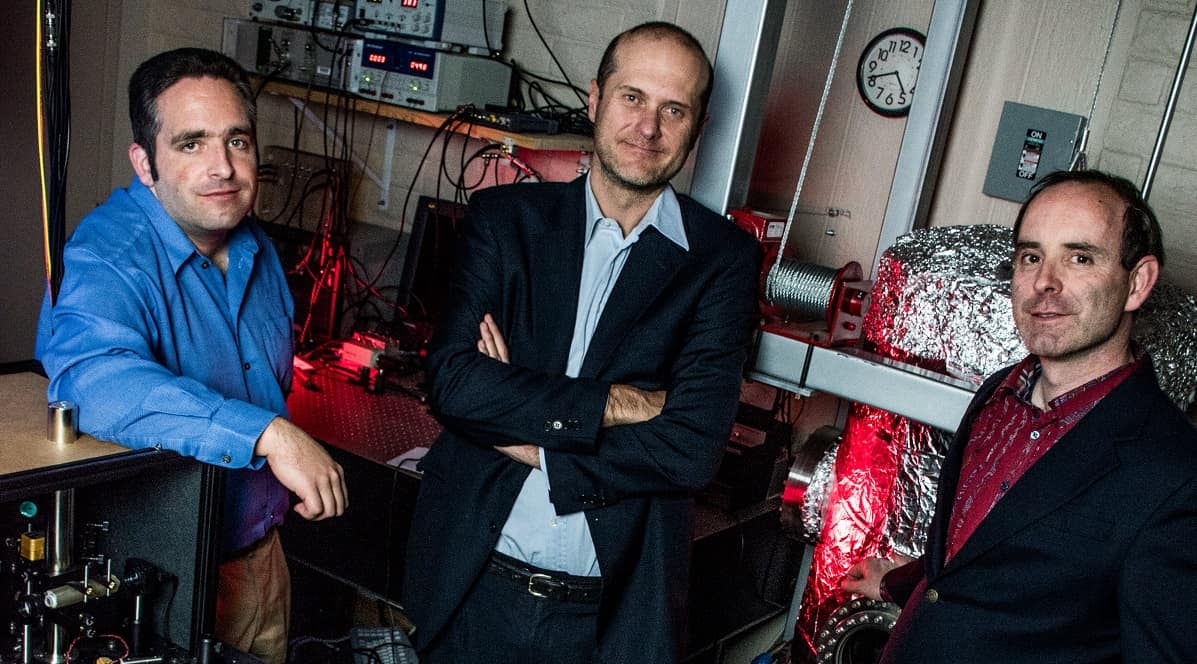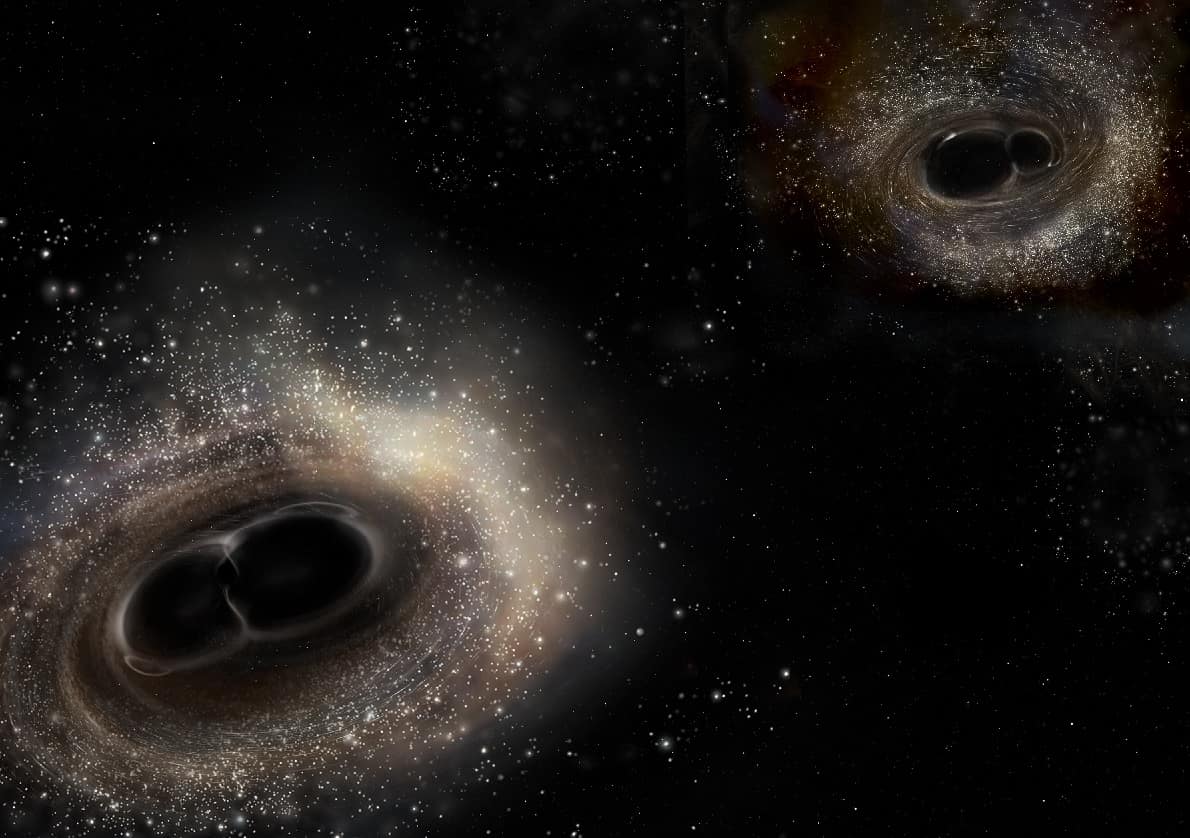The Sounds of Space: Prescott Campus Faculty, Students Help Prove Einstein’s Theory Correct

On Sept. 14, 2015, Embry-Riddle Aeronautical University astrophysics faculty and students at the Prescott Campus in Arizona joined colleagues around the world in listening to the very first notes of what they hope will one day be a symphony of sound coming from the universe.
On that day, the Laser Interferometer Gravitational Wave Observatory, or LIGO, recorded the first evidence of gravitational waves — ripples in space time first predicted by Albert Einstein a century ago. The “chirp” detected was the signature sound of two massive black holes merging together 1.3 billion light years from Earth, and it was music to the ears of Prescott physics faculty Michele Zanolin, Brennan Hughey and Andri Gretarsson, and their students.
“We’ve been saying for years that we wanted to listen to the universe, to add ears to the eyes, but it didn’t become real until we actually had a detection,” says Gretarsson, an associate professor who first began working on LIGO as a student in 1996.
“With sound you can listen to the heart of a baby or you can listen to a symphony orchestra,” adds Zanolin, associate professor and Embry-Riddle’s principal investigator on a LIGO project that has brought about $1 million in National Science Foundation funding to the university. “Hopefully in the future we can listen to different songs from different sources.”
It’s that opportunity to listen to different songs that excites Hughey, an assistant professor of physics. “Supernovae are going to look and sound different, and a cosmic string will sound and look different again, so in another 20 years we’d like to be able to listen to this whole symphony of gravitational waves.”
The headphones for all this celestial music are the pair of 4-kilometer-long, L-shaped laser rangefinders — one in Livingston, La., and another in Hanford, Wash. — that comprise LIGO. A gravitational wave reaching the Earth will stretch one arm of the L and squeeze the other by a mere ten-thousandth the width of a proton. But in a machine this sensitive, even such an infinitesimally small disruption of the laser beams inside can be detected.
Embry-Riddle is part of the LIGO Scientific Collaboration (LSC), which comprises more than 1,000 scientists from hundreds of universities and research institutes around the world. Zanolin, Hughey and Gretarsson have been part of the LSC for years, helping to build and test the devices and to create the software needed to catch a gravitational wave as it passed through the detectors.
Hailing from some of the leading physics labs in the world — Zanolin and Hughey from MIT and Gretarsson from Caltech — the researchers have built a robust gravitational wave astrophysics program in Prescott, particularly in the area of supernovae.
FIRST DETECTION
Zanolin, Hughey and Gretarsson say they greeted news of a detection from LIGO with a certain amount of skepticism, born of a deliberate effort by the project’s leaders to build in safeguards that would ensure it couldn’t be anything else before they went public.
“The signal that we saw was such a slam dunk that it gave us a lot of confidence that it was a real signal,” Hughey says. “You couldn’t ask for a more beautiful signal than the one we had.”
Zanolin says it took a week before the now-historic detection sunk in. “By then I felt like I had won an enormous lottery. It’s like one day you discover you have a new sense. I felt like a Jedi.”
But perhaps his favorite part of the discovery? The confirmation of gravitational waves only begged many new questions. “Sometimes you have a discovery that’s like finding a remote little island that no one has ever seen before, and you map it and you’re done,” Zanolin says. “This was like discovering a new continent, and we still don’t know where it ends. There are an enormous number of physics questions we can now explore.”

LOOKING TO THE FUTURE
Moving forward, Zanolin is focused on supernovae, exploding stars that produce the most powerful explosions in the universe. But he says sometimes, instead of vaporizing, the supernova fails and collapses into a black hole.
“It turns out that black holes are the output of failed supernovae,” Zanolin says, “so the cool thing is that the black holes we are detecting will establish how many failed supernovae are out there. If we continue to detect binary black hole systems, we’ll be able to study the physics of supernovae through the population of those systems.”
Zanolin says he would like to see the next LIGO instrument have arms 40 km long, because “longer wavelengths make the interferometer more sensitive.”
Gretarsson, who specializes in the optical coatings on LIGO’s incredibly sensitive mirrors, says he is now focused on future upgrades to LIGO that would detect gravitational waves at a rate 100 times higher than the current instrument.
“Right now we’re looking through something like Galileo’s telescope. We’d like to ultimately get to the gravitational wave equivalent of the Hubble Telescope,” Gretarsson says. “It’s still pretty insensitive given all the sources that are out there. We’ve just gotten to the point where we can hear things, and that required 40 years of effort.”
THE NEXT GENERATION
As excited as the researchers are about the new opportunities to pursue their research, they are equally excited about sharing the discovery with their students. All of them say they were attracted to Embry-Riddle because it offered an ideal mix of research and teaching.
“It’s a pretty exciting place to be,” says Hughey, who was a post-doctoral researcher at MIT with Zanolin. “My goal with research is to give students a hands-on experience in dealing with data and to participate as collaborators on real, active physics experiments. They are real researchers and are officially part of the collaboration.”
In fact, Embry-Riddle undergraduate Kiranjyot “Jasmine” Gill is the youngest of the 1,004 authors on the paper announcing the detection and discovery of the merging black holes in the prestigious journal Physical Review Letters.
Gill, who aspires to be an astronaut, is presently working to improve how scientists identify gravitational waves that occur when a supernova collapses. Collaborating with Zanolin and Ph.D. student Marek Jan Szczepańczyk, she is researching how often these massive star explosions happen in the local universe, a region of approximately 1 billion light years in radius, to aid in future LIGO detections.
Szczepańczyk, who presented his work at the International Conference on General Relativity and Gravitation in New York last year, came to Embry-Riddle after finishing a master’s degree in Poland. Now, he chairs the LIGO supernova research group.
“At a recent meeting, Ray Weiss and Kip Thorne, the founding fathers of LIGO, were talking quite a bit about supernovae, and here we are leading the world in supernova science. That’s a good feeling,” Szczepańczyk says. It’s students like these who inspire Zanolin.
“When someone is 20, they believe that everything is possible,” he says. “When I’m working with them, I think the same way. Everything is possible.”
